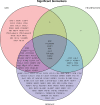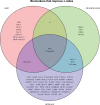Protein Biomarkers of New-Onset Heart Failure: Insights From the Heart Omics and Ageing Cohort, the Atherosclerosis Risk in Communities Study, and the Framingham Heart Study
- PMID: 37192292
- PMCID: PMC10179982
- DOI: 10.1161/CIRCHEARTFAILURE.122.009694
Protein Biomarkers of New-Onset Heart Failure: Insights From the Heart Omics and Ageing Cohort, the Atherosclerosis Risk in Communities Study, and the Framingham Heart Study
Abstract
Background: We sought to identify protein biomarkers of new-onset heart failure (HF) in 3 independent cohorts (HOMAGE cohort [Heart Omics and Ageing], ARIC study [Atherosclerosis Risk in Communities], and FHS [Framingham Heart Study]) and assess if and to what extent they improve HF risk prediction compared to clinical risk factors alone.
Methods: A nested case-control design was used with cases (incident HF) and controls (without HF) matched on age and sex within each cohort. Plasma concentrations of 276 proteins were measured at baseline in ARIC (250 cases/250 controls), FHS (191/191), and HOMAGE cohort (562/871).
Results: In single protein analysis, after adjusting for matching variables and clinical risk factors (and correcting for multiple testing), 62 proteins were associated with incident HF in ARIC, 16 in FHS, and 116 in HOMAGE cohort. Proteins associated with incident HF in all cohorts were BNP (brain natriuretic peptide), NT-proBNP (N-terminal pro-B-type natriuretic peptide), eukaryotic translation initiation factor 4E-BP1 (4E-binding protein 1), hepatocyte growth factor (HGF), Gal-9 (galectin-9), TGF-alpha (transforming growth factor alpha), THBS2 (thrombospondin-2), and U-PAR (urokinase plasminogen activator surface receptor). The increment in C-index for incident HF based on a multiprotein biomarker approach, in addition to clinical risk factors and NT-proBNP, was 11.1% (7.5%-14.7%) in ARIC, 5.9% (2.6%-9.2%) in FHS, and 7.5% (5.4%-9.5%) in HOMAGE cohort, all P<0.001), each of which was a larger increase than that for NT-proBNP on top of clinical risk factors. Complex network analysis revealed a number of overrepresented pathways related to inflammation (eg, tumor necrosis factor and interleukin) and remodeling (eg, extracellular matrix and apoptosis).
Conclusions: A multiprotein biomarker approach improves prediction of incident HF when added to natriuretic peptides and clinical risk factors.
Keywords: biomarkers; cardiovascular diseases; heart failure; protein interaction maps; proteomics.
Conflict of interest statement
Figures




References
-
- Petrie M, McMurray J. Changes in notions about heart failure. Lancet. 2001;358:432–434. doi: 10.1016/S0140-6736(01)05664-1 - PubMed
-
- Conrad N, Judge A, Tran J, Mohseni H, Hedgecott D, Crespillo AP, Allison M, Hemingway H, Cleland JG, McMurray JJV, et al. . Temporal trends and patterns in heart failure incidence: a population-based study of 4 million individuals. Lancet. 2018;391:572–580. doi: 10.1016/s0140-6736(17)32520-5 - PMC - PubMed
-
- Manzano L, Babalis D, Roughton M, Shibata M, Anker SD, Ghio S, van Veldhuisen DJ, Cohen-Solal A, Coats AJ, Poole-Wilson PPA, et al. . Predictors of clinical outcomes in elderly patients with heart failure. Eur J Heart Fail. 2011;13:528–536. doi: 10.1093/eurjhf/hfr030 - PubMed
-
- Ponikowski P, Voors AA, Anker SD, Bueno H, Cleland JGF, Coats AJS, Falk V, González-Juanatey JR, Harjola V-P, Jankowska EA, et al. ; Authors/Task Force Members. 2016 ESC Guidelines for the diagnosis and treatment of acute and chronic heart failure: the Task Force for the diagnosis and treatment of acute and chronic heart failure of the European Society of Cardiology (ESC). Developed with the special contribution of the Heart Failure Association (HFA) of the ESC. Eur J Heart Fail. 2016;18:891–975. doi: 10.1002/ejhf.592 - PubMed
Publication types
MeSH terms
Substances
LinkOut - more resources
Full Text Sources
Medical
Research Materials
Miscellaneous

